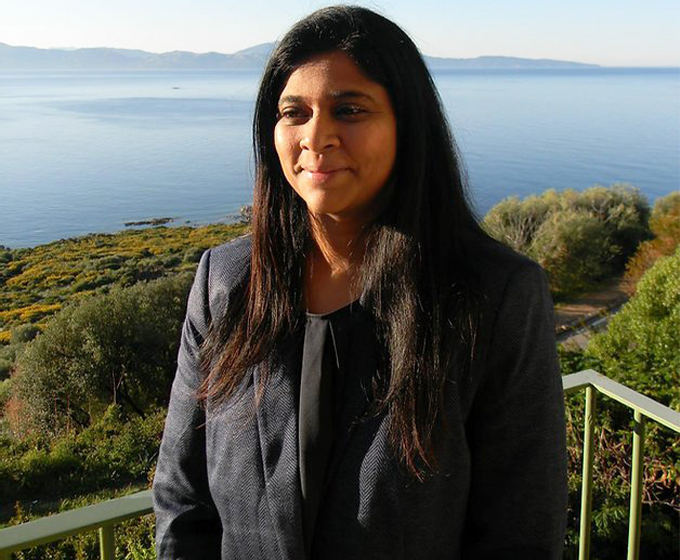
SEPTEMBER 29, 2020 — Recently published research spearheaded by UTSA finds that outdoor areas may not be as safe as first thought to protect against the coronavirus. The study was conducted by Kiran Bhaganagar, associate professor of mechanical engineering. To develop her findings, Bhaganagar utilized data available from a United States COVID-19 hot spot—New York City.
According to Bhaganagar, this is the first study to measure spread of coronavirus in outdoor conditions. There is enough evidence that aerosols spread the virus indoors. To conduct her research, Bhaganagar obtained detailed meteorological fields to create highly accurate models that show likely spread of the virus under various weather patterns in New York City from March through April 2020.
Using computer modeling, she created a real-time, high-fidelity simulation of a virus-filled cough as it was released into the atmosphere from an infected person. As the person coughs or sneezes, respiratory droplets that contain infectious particles are released into the air. The simulations found that combinations of certain weather conditions favor the spread of the virus.
Bhaganagar discovered windy conditions did little to spread the coronavirus droplets; in fact, that weather condition actually caused the aerosol droplets to disperse faster.
Instead, the testing showed that the combination of warmer or moderately cold air temperatures, with low wind speed and weak turbulence, increases the amount of time the virus can be airborne before getting dispersed in the air—up to 30 minutes in many cases. In low wind conditions, Bhaganagar discovered coronavirus aerosol particles can spread from 1 to 2 kilometers, or a little over a mile.
Simulating Viral Spread
This computer animation shows how the right weather conditions likely spread coronavirus droplets across the Hudson River and into New Jersey.
Depending on the time of the day and depending on the wind direction, the direction of spread was either toward Massachusetts, toward New Jersey or toward southern New York.
Based on Bhaganagar’s cumulative information, she said it’s highly likely that outdoor conditions also contributed to the wildfire-like spread of the coronavirus in the NYC metro area during spring 2020.
“This work is further evidence that outdoor air cannot dilute the virus particles, and there is strong evidence the spatial spread across states is linked to airborne transmission,” said Bhaganagar.
⇒ Read about more of Bhaganagar’s research in UTSA Today.
Based on the distance coronavirus aerosol can spread outdoors, Bhaganagar says her study suggests that outdoors 6 feet may not be adequate social distance to protect from the virus. She added the use of masks and other means of virus protection in outdoor areas are additional precautions to consider against contracting COVID-19.
Bhaganagar’s entire study was published in Environmental Research, Science Direct, on September 17. UTSA Ph.D. student Sudheer Bhimireddy assisted on the project.
UTSA Today is produced by University Communications and Marketing, the official news source of The University of Texas at San Antonio. Send your feedback to news@utsa.edu. Keep up-to-date on UTSA news by visiting UTSA Today. Connect with UTSA online at Facebook, Twitter, Youtube and Instagram.
Move In To COLFA is strongly recommended for new students in COLFA. It gives you the chance to learn about the Student Success Center, campus resources and meet new friends!
Academic Classroom: Lecture Hall (MH 2.01.10,) McKinney Humanities BldgWe invite you to join us for Birds Up! Downtown, an exciting welcome back event designed to connect students with the different departments at the Downtown Campus. Students will have the opportunity to learn about some of the departments on campus, gain access to different resources, and collect some giveaways!
Bill Miller PlazaJoin us for an intimate evening of cocktails, conversation, and culinary inspiration with Pati Jinich, Emmy-nominated chef and James Beard Award-winning author. Enjoy light bites and signature drinks in the warm, modern setting of Mezquite as Pati connects with guests over her passion for Mexican cuisine and storytelling.
Mezquite Restaurant in Pullman Market, 221 Newell Ave., San Antonio 78215From inspired courses to thoughtful pairings and a rich sense of community, the Ven a Comer Signature Dinner is a night of shared meals, shared stories, and unforgettable flavor.
Stable Hall (Pear Brewery), 307 Pearl Pkwy, San Antonio 78215Come and celebrate this year's homecoming at the Downtown Campus with food, games, giveaways, music, and more. We look forward to seeing your Roadrunner Spirit!
Bill Miller PlazaThe University of Texas at San Antonio is dedicated to the advancement of knowledge through research and discovery, teaching and learning, community engagement and public service. As an institution of access and excellence, UTSA embraces multicultural traditions and serves as a center for intellectual and creative resources as well as a catalyst for socioeconomic development and the commercialization of intellectual property - for Texas, the nation and the world.
To be a premier public research university, providing access to educational excellence and preparing citizen leaders for the global environment.
We encourage an environment of dialogue and discovery, where integrity, excellence, respect, collaboration and innovation are fostered.